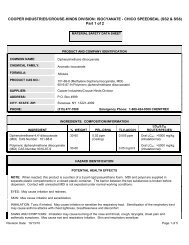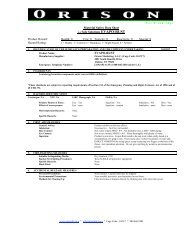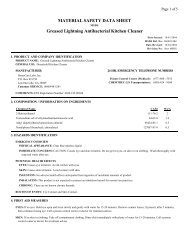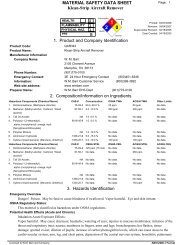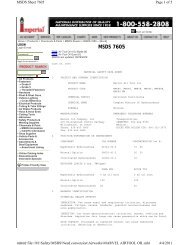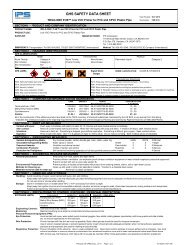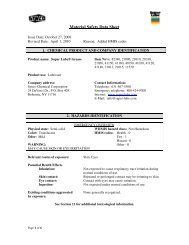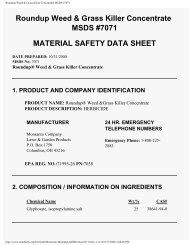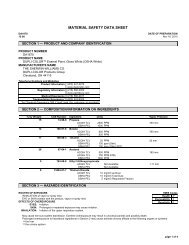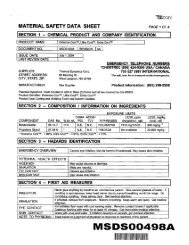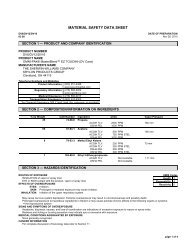SW DURATION® Satin Exterior Acrylic Latex Extra White Tinting Base
SW DURATION® Satin Exterior Acrylic Latex Extra White Tinting Base
SW DURATION® Satin Exterior Acrylic Latex Extra White Tinting Base
- No tags were found...
Create successful ePaper yourself
Turn your PDF publications into a flip-book with our unique Google optimized e-Paper software.
MATERIAL SAFETY DATA SHEETK33W15118 00DATE OF PREPARATIONNov 29, 2010SECTION 1 — PRODUCT AND COMPANY IDENTIFICATIONPRODUCT NUMBERK33W151PRODUCT NAMEDURATION® <strong>Satin</strong> <strong>Exterior</strong> <strong>Acrylic</strong> <strong>Latex</strong>, <strong>Extra</strong> <strong>White</strong> <strong>Tinting</strong> <strong>Base</strong>MANUFACTURER'S NAMETHE SHERWIN-WILLIAMS COMPANY101 Prospect Avenue N.W.Cleveland, OH 44115Telephone Numbers and WebsitesProduct Information www.sherwin-williams.comRegulatory Information (216) 566-2902www.paintdocs.comMedical Emergency (216) 566-2917Transportation Emergency* (800) 424-9300*for Chemical Emergency ONLY (spill, leak, fire, exposure, or accident)SECTION 2 — COMPOSITION/INFORMATION ON INGREDIENTS% by Weight CAS Number Ingredient Units Vapor Pressure1 64742-54-7 Heavy Paraffinic OilACGIH TLV 5 mg/m3 as Mist 0.0004 mmOSHA PEL 5 mg/m3 as Mist2 107-21-1 Ethylene GlycolACGIH TLV 100 MG/M3 CEILING (aerosol) 0.12 mmOSHA PEL 50 PPM CEILING0.1 14464-46-1 CristobaliteACGIH TLV 0.025 mg/m3 as Resp. DustOSHA PEL 0.05 mg/m3 as Resp. Dust16 13463-67-7 Titanium DioxideACGIH TLV 10 mg/m3 as DustOSHA PEL 10 mg/m3 Total DustOSHA PEL 5 mg/m3 Respirable Fraction5 1314-13-2 Zinc OxideACGIH TLV 10 mg/m3 as DustOSHA PEL 10 mg/m3 Total DustOSHA PEL 5 mg/m3 Respirable FractionSECTION 3 — HAZARDS IDENTIFICATIONROUTES OF EXPOSUREINHALATION of vapor or spray mist.EYE or SKIN contact with the product, vapor or spray mist.EFFECTS OF OVEREXPOSUREEYES: Irritation.SKIN: Prolonged or repeated exposure may cause irritation.INHALATION: Irritation of the upper respiratory system.HMIS CodesHealth 2*Flammability 0Reactivity 0In a confined area vapors in high concentration may cause headache, nausea or dizziness.Prolonged overexposure to hazardous ingredients in Section 2 may cause adverse chronic effects to the following organs or systems:the liverthe urinary systemSIGNS AND SYMPTOMS OF OVEREXPOSURERedness and itching or burning sensation may indicate eye or excessive skin exposure.MEDICAL CONDITIONS AGGRAVATED BY EXPOSURENone generally recognized.page 1 of 4
K33W151CANCER INFORMATIONFor complete discussion of toxicology data refer to Section 11.SECTION 4 — FIRST AID MEASURESEYES:SKIN:INHALATION:INGESTION:Flush eyes with large amounts of water for 15 minutes. Get medical attention.Wash affected area thoroughly with soap and water.Remove contaminated clothing and launder before re-use.If affected, remove from exposure. Restore breathing. Keep warm and quiet.Do not induce vomiting. Get medical attention immediately.SECTION 5 — FIRE FIGHTING MEASURESFLASH POINTLEL UEL FLAMMABILITY CLASSIFICATIONNot ApplicableN.A. N.A. Not ApplicableEXTINGUISHING MEDIACarbon Dioxide, Dry Chemical, Alcohol FoamUNUSUAL FIRE AND EXPLOSION HAZARDSClosed containers may explode (due to the build-up of pressure) when exposed to extreme heat.During emergency conditions overexposure to decomposition products may cause a health hazard. Symptoms may not be immediatelyapparent. Obtain medical attention.SPECIAL FIRE FIGHTING PROCEDURESFull protective equipment including self-contained breathing apparatus should be used.Water spray may be ineffective. If water is used, fog nozzles are preferable. Water may be used to cool closed containers to prevent pressurebuild-up and possible autoignition or explosion when exposed to extreme heat.SECTION 6 — ACCIDENTAL RELEASE MEASURESSTEPS TO BE TAKEN IN CASE MATERIAL IS RELEASED OR SPILLEDRemove all sources of ignition. Ventilate the area.Remove with inert absorbent.SECTION 7 — HANDLING AND STORAGESTORAGE CATEGORYNot ApplicablePRECAUTIONS TO BE TAKEN IN HANDLING AND STORAGEKeep container closed when not in use. Transfer only to approved containers with complete and appropriate labeling. Do not take internally.Keep out of the reach of children.SECTION 8 — EXPOSURE CONTROLS/PERSONAL PROTECTIONPRECAUTIONS TO BE TAKEN IN USEUse only with adequate ventilation.Avoid contact with skin and eyes. Avoid breathing vapor and spray mist.Wash hands after using.This coating may contain materials classified as nuisance particulates (listed "as Dust" in Section 2) which may be present at hazardous levelsonly during sanding or abrading of the dried film. If no specific dusts are listed in Section 2, the applicable limits for nuisance dusts areACGIH TLV 10 mg/m3 (total dust), 3 mg/m3 (respirable fraction), OSHA PEL 15 mg/m3 (total dust), 5 mg/m3 (respirable fraction).Removal of old paint by sanding, scraping or other means may generate dust or fumes that contain lead. Exposure to lead dust or fumes maycause brain damage or other adverse health effects, especially in children or pregnant women. Controlling exposure to lead or otherhazardous substances requires the use of proper protective equipment, such as a properly fitted respirator (NIOSH approved) and propercontainment and cleanup. For more information, call the National Lead Information Center at 1-800-424-LEAD (in US) or contact your localhealth authority.VENTILATIONLocal exhaust preferable. General exhaust acceptable if the exposure to materials in Section 2 is maintained below applicable exposure limits.Refer to OSHA Standards 1910.94, 1910.107, 1910.108.RESPIRATORY PROTECTIONIf personal exposure cannot be controlled below applicable limits by ventilation, wear a properly fitted organic vapor/particulate respiratorapproved by NIOSH/MSHA for protection against materials in Section 2.When sanding or abrading the dried film, wear a dust/mist respirator approved by NIOSH/MSHA for dust which may be generated from thisproduct, underlying paint, or the abrasive.PROTECTIVE GLOVE<strong>SW</strong>ear gloves which are recommended by glove supplier for protection against materials in Section 2.EYE PROTECTIONWear safety spectacles with unperforated sideshields.page 2 of 4
K33W151SECTION 9 — PHYSICAL AND CHEMICAL PROPERTIESPRODUCT WEIGHT 10.54 lb/gal 1263 g/lSPECIFIC GRAVITY 1.27BOILING POINT 212 - 500 °F 100 - 260 °CMELTING POINT Not AvailableVOLATILE VOLUME 59%EVAPORATION RATE Slower than etherVAPOR DENSITY Heavier than airSOLUBILITY IN WATER N.A.pH 8.5VOLATILE ORGANIC COMPOUNDS (VOC Theoretical - As Packaged)0.94 lb/gal 113 g/l Less Water and Federally Exempt Solvents0.43 lb/gal 51 g/l Emitted VOCSECTION 10 — STABILITY AND REACTIVITYSTABILITY — StableCONDITIONS TO AVOIDNone known.INCOMPATIBILITYNone known.HAZARDOUS DECOMPOSITION PRODUCTSBy fire: Carbon Dioxide, Carbon MonoxideHAZARDOUS POLYMERIZATIONWill not occurSECTION 11 — TOXICOLOGICAL INFORMATIONCHRONIC HEALTH HAZARDSCrystalline Silica (Quartz, Cristobalite) is listed by IARC and NTP. Long term exposure to high levels of silica dust, which can occur only whensanding or abrading the dry film, may cause lung damage (silicosis) and possibly cancer.IARC's Monograph No. 93 reports there is sufficient evidence of carcinogenicity in experimental rats exposed to titanium dioxide butinadequate evidence for carcinogenicity in humans and has assigned a Group 2B rating. In addition, the IARC summary concludes, "Nosignificant exposure to titanium dioxide is thought to occur during the use of products in which titanium is bound to other materials, such aspaint."Ethylene Glycol is considered an animal teratogen. It has been shown to cause birth defects in rats and mice at high doses when given indrinking water or by gavage. There is no evidence to indicate it causes birth defects in humans.TOXICOLOGY DATACAS No.Ingredient Name64742-54-7 Heavy Paraffinic Oil107-21-1 Ethylene Glycol14464-46-1 Cristobalite13463-67-7 Titanium Dioxide1314-13-2 Zinc OxideSECTION 12 — ECOLOGICAL INFORMATIONLC50 RAT 4HR Not AvailableLD50 RATNot AvailableLC50 RAT 4HR Not AvailableLD50 RAT4700 mg/kgLC50 RAT 4HR Not AvailableLD50 RATNot AvailableLC50 RAT 4HR Not AvailableLD50 RATNot AvailableLC50 RAT 4HR Not AvailableLD50 RATNot AvailableECOTOXICOLOGICAL INFORMATIONNo data available.SECTION 13 — DISPOSAL CONSIDERATION<strong>SW</strong>ASTE DISPOSAL METHODWaste from this product is not hazardous as defined under the Resource Conservation and Recovery Act (RCRA) 40 CFR 261.page 3 of 4
K33W151Incinerate in approved facility. Do not incinerate closed container. Dispose of in accordance with Federal, State/Provincial, and Localregulations regarding pollution.SECTION 14 — TRANSPORT INFORMATIONUS Ground (DOT)Not Regulated for Transportation.Canada (TDG)Not Regulated for Transportation.IMONot Regulated for Transportation.SECTION 15 — REGULATORY INFORMATIONSARA 313 (40 CFR 372.65C) SUPPLIER NOTIFICATIONCAS No. CHEMICAL/COMPOUND % by WT % Element107-21-1 Ethylene Glycol 2Zinc Compound 5 3.7CALIFORNIA PROPOSITION 65WARNING: This product contains chemicals known to the State of California to cause cancer and birth defects or other reproductive harm.TSCA CERTIFICATIONAll chemicals in this product are listed, or are exempt from listing, on the TSCA Inventory.SECTION 16 — OTHER INFORMATIONThis product has been classified in accordance with the hazard criteria of the Canadian Controlled Products Regulations (CPR) and theMSDS contains all of the information required by the CPR.The above information pertains to this product as currently formulated, and is based on the information available at this time. Addition of reducers or otheradditives to this product may substantially alter the composition and hazards of the product. Since conditions of use are outside our control, we make nowarranties, express or implied, and assume no liability in connection with any use of this information.page 4 of 4



